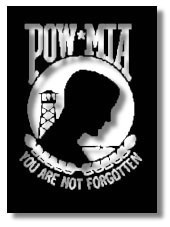
Prisoners of War, soldiers captured by enemy soldiers during times of war, are casualties that can all too often be easy to forget. You can't ignore the image of crosses lined in neat rows at Arlington, and other National cemeteries, that remind us of the high cost of freedom. In any gathering of veterans, the scars of war wounds and evidence of missing limbs quickly reminds us of the sacrifice of those who have fought for freedom. It is impossible to forget those Killed in Action (KIA) or Wounded In Action (WIA) because the evidence of their sacrifice is ever before us.
Sadly, the same can not be said for those who are Missing In Action or who may have been taken prisoner by the enemy and never repatriated.
Since World War
I more than 200,000 Americans have been listed as Prisoners of War or Missing in Action. Less than half of them were returned at the end of hostilities, leaving more than 125,000 American servicemen Missing In Action since the beginning of World War I.
During the 14-years of American involvement in Southeast Asia, and specifically the Vietnam War, more than 2,500 Americans were captured or listed as missing in action. The politics of our Nation's most unpopular war could have eclipsed the fate of these dedicated soldiers, were it not for the NATIONAL LEAGUE OF FAMILIES. As the spouses, children, parents and other family members of soldiers missing in Southeast Asia banded together to keep the plight of their loved ones before the American conscience, the organization grew in strength and influence that reached all the way into the White House. Through the League the missing and the imprisoned servicemen had a voice, but by 1971 something more was needed. Mrs. Michael Hoff, whose husband was among the missing, believed that what the cause lacked was a standard....a flag to remind more fortunate families of those who were still unaccounted for.
It was during this period of time that the People's Republic of China was admitted to the United Nations. Annin & Company was one of the largest manufacturers of flags in the world, and made it their policy to provide flags for each member of that organization. One day, while reading an article in the Jacksonville, Florida Times-Union about this matter, Mrs. Hoff decided to contact Annin's Vice President Norman Rivkees about providing a flag for soldiers captured or missing. Mr. Rivkees quickly adopted the idea, and turned to one of their advertising agencies to consider drafting a design.
|
 Newt Heisley Newt Heisley
Newt Heisley was a pilot during World War II, a dangerous role that accounts for many war-time POWs and MIAs. Years after the war he had come to New York looking for work. "It took me four days to find a bad job at low pay," he later said of his introduction to "Big Apple" advertising agencies. But, by working hard, by 1971 he had gradually moved upward in the industry, eventually working for an agency with many national accounts.
As a veteran, the call for a flag designed to raise awareness of our Nation's POW/MIAs was a personal challenge. It was even more challenging when he considered that his oldest son Jeffrey was, during these Vietnam War years, training for combat with the United States Marines at Quantico, Virginia. As he pondered this new challenge a series of events set in motion the ideas that would create a flag unlike anything since the days of Betsy Ross. First, Jeffery became very ill while training for combat. The illness, diagnosed as hepatitis, ravaged his body emaciating his face and structure. When he returned home, medically discharged and unable to continue further, his father looked in horror at what had once been a strong, young man. Then, as Newt Heisley looked closer at his son's gaunt features, he began to imagine what life must be like for those behind barbed wire fences on foreign shores. Slowly he began to sketch the profile of his son, working in pencil to create a black and white silhouette, as the new flag's design was created in his mind. Barbed wire, a tower, and most prominently the visage of a gaunt young man became the initial proposal.
Newt Heisley's black and white pencil sketch was one of several designs considered for the new POW/MIA flag. Newt planned, should his design be accepted, to add color at a later date...perhaps a deep purple and white. "In the advertising industry, you do everything in black and white first, then add the color," he says. Mr. Heisley's proposal for the new flag was unique. Rarely does a flag prominently display the likeness of a person. None-the-less, it was the design featuring the gaunt silhouette of his son Jeffrey that was accepted and, before Mr. Heisly could return to refine his proposal and add the colors he had planned, the black and white flags were already being printed in quantity by Annon & Company. (Though the POW/MIA flag has been produced in other colors, often in red and white, the black and white design became the most commonly used version.)
The design for the MIA/POW flag was never copyrighted. It became a flag that belongs to everyone, a design that hauntingly reminds us of those we dare not ever forget. Behind the black and white silhouette is a face we can't see...the face of a husband, a father, or a son who has paid with their freedom, for our freedom. Beneath the image are the words....
You Are Not Forgotten |